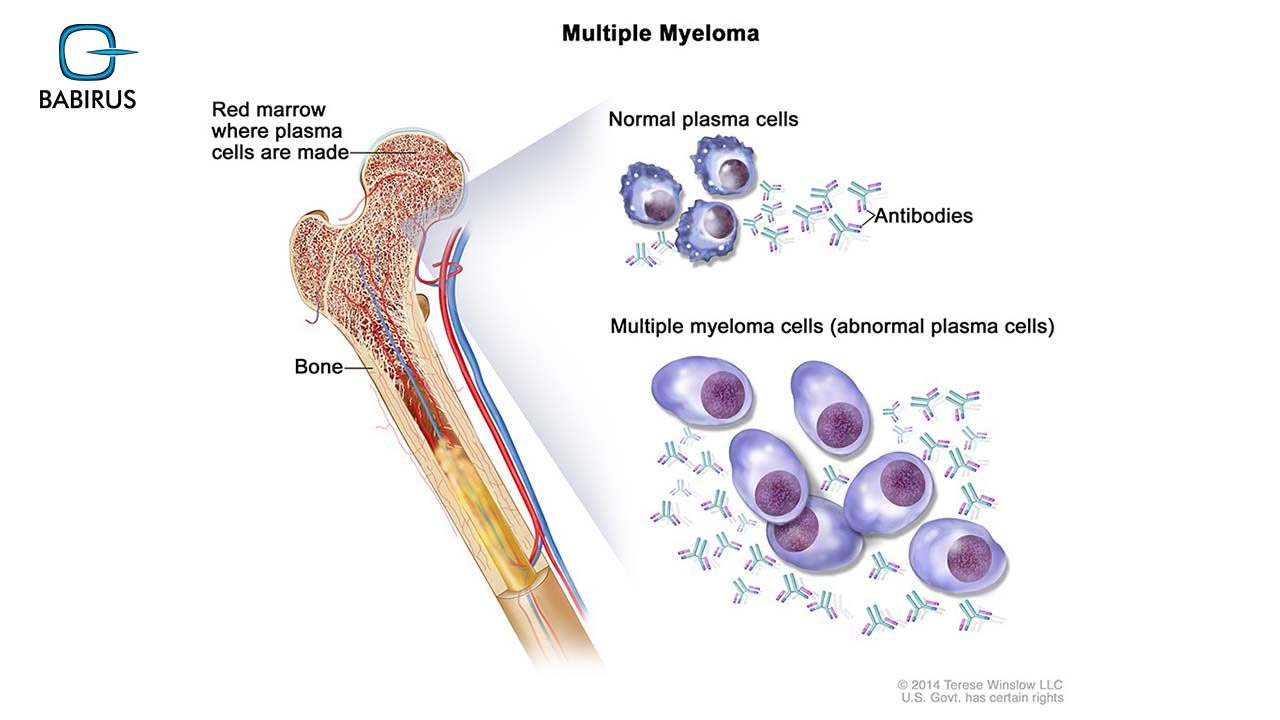What is Multiple Myeloma? Symptoms, Diagnosis, and Treatment

Plasma cells perform a vital role in immune function by producing antibodies that protect our bodies against infections and contribute to immunological memory.
However, when plasma cells undergo malignant transformation, it can lead to the development of multiple myeloma, a complex cancer involving abnormal proliferation of plasma cells in the bone core.
In this article, we will delve into the symptoms, diagnosis, and treatment options for multiple myeloma.
What is Multiple Myeloma?
Multiple myeloma, also known as plasma cell cancer, is a type of cancer that affects plasma cells a basic blood component.
Moreover, normal plasma cells are created in the bone marrow (the spongy inner layer of your bones that produces your blood cells) and are white blood cells that form the body’s immune system and help the body fight infection by making antibodies that attack viruses or bacteria.
However, when the plasma cell develops cancer, it starts to:
- Multiply rapidly.
- Reject healthy blood-making cells in the bone marrow.
- Make an abnormal antibody, that does not fight infection, instead, they make m protein (a type of antibody that helps fight infection).
The 8 Basic Multiple Myeloma Symptoms:
The symptoms of multiple myeloma can differ from one person to another, and some people may not experience any symptoms in the early multiple myeloma stages.
However, as the condition progresses, common symptoms may be included, yet it is important to note that these symptoms can also be revealing of other health conditions, so it is essential to consult a healthcare professional for an accurate diagnosis:
- Bone pain, especially in the back, hips, or skull.
- Weakness and fatigue.
- Recurrent infections.
- Easy bruising and bleeding.
- Nausea, vomiting, or constipation.
- Increased thirst and urination.
- Numbness or weakness in the legs.
- Weight loss.
4 Main Multiple Myeloma Causes:
While the particular root of multiple myeloma is not fully understood, yet, studies highlight several big factors as potential contributors to the development of this malignant condition:
1. Genetic Predisposition:
One of the primary reasons for multiple myeloma is believed to be a genetic predisposition, as individuals with a family history of multiple myeloma or certain genetic mutations may have an increased risk of developing the disease.
More than that, studies have shown that specific genetic abnormalities, such as translocations involving the immunoglobulin heavy chain gene (IgH), are related to a high risk of multiple myeloma.
2. Environmental Exposures:
Exposure to certain environmental factors has also been linked to an increased risk of developing multiple myeloma and other dangerous conditions.
Furthermore, continued exposure to ionizing radiation, such as high levels of radiation from X-rays or other sources, has been identified as a potential risk factor for the development of this condition.
Additionally, continuous contact with certain chemicals and toxins, including benzene and pesticides, has been associated with a raised risk of multiple myeloma.
3. Immune System Dysfunction:
The malfunctioning of the immune system is another factor that may lead to the development of multiple myeloma because plasma cells are a basic component of the immune system. Thus, any abnormalities or dysregulation in immune function can potentially cause the uncontrolled growth of these cells, resulting in multiple myeloma.
Moreover, some autoimmune conditions and immunodeficiency disorders have been linked to an increased vulnerability to developing this type of cancer.
4. Monoclonal Gammopathy of Undetermined Significance (MGUS):
Monoclonal gammopathy of undetermined significance (MGUS) is a precursor condition to multiple myeloma, as people with MGUS have an irregular protein in their blood, known as monoclonal protein or M protein.
However, while most people with MGUS do not develop multiple myeloma, yet, having MGUS increases the risk of eventually developing this cancer, although the exact mechanisms causing the progression from MGUS to multiple myeloma are not fully understood but are believed to involve a grouping of genetic and environmental factors.
Multiple Myeloma Diagnosis Steps:
Diagnosing multiple myeloma often involves a combination of medical history assessment, physical examination, and various tests including:
- Blood tests: including the CBC testsand others to reveal abnormal levels of certain proteins or blood cell counts.
- Urine tests: Urine samples can be analyzed for abnormal proteins associated with multiple myeloma.
- Bone core biopsy: A small sample of bone marrow is extracted and examined for cancerous plasma cells.
- Imaging tests: X-rays, CT scans, MRI scans, or PET scans may be used to detect bone abnormalities or tumors.
More than that, once diagnosed with multiple myeloma, further tests may be conducted to determine the extent and stage of the disease.
Popular Multiple Myeloma Treatment:
The treatment approach for multiple myeloma depends on various factors including the stage of the disease, overall health status, and individual preferences, yet, common treatment options may include:
- Chemotherapy: Medications are used to kill cancer cells or stop their growth.
- Immunomodulatory drugs: These drugs help improve the immune system’s response to cancer cells.
- Targeted therapy: Specific drugs target certain abnormalities within cancer cells.
- Stem cell transplant: High-dose chemotherapy is followed by a transplant of healthy stem cells to help rebuild healthy bone marrow.
On the other hand, there are some supportive therapies such as pain management, bisphosphonates to strengthen bones, and radiation therapy may be utilized to manage symptoms and improve quality of life.
3 Common Questions about Multiple Myeloma:
These are the accurate and scientific answers for the most FAQs about multiple myeloma:
1. What is the life expectancy of a person with multiple myeloma?
According to the American Cancer Society (ACS), the relative 5-year survival rate for multiple myeloma has been improving over the years due to advancements in treatment, moreover, the 5-year survival rate refers to the percentage of people who are still alive 5 years after their diagnosis.
However, it is vital to note that survival rates are statistical numbers based on previous outcomes of large numbers of people who had the disease, yet that does not necessarily imply on each person’s condition.
2. What is the main cause of multiple myeloma?
Scientists still do not know exactly what causes most cases of multiple myeloma, however, they have made progress in understanding how certain changes in DNA can make plasma cells become cancerous.
3. Is it possible to recover from multiple myeloma?
Recovery from multiple myeloma can vary depending on factors such as the stage of the disease at diagnosis, the patient’s overall health, and their response to treatment.
On one hand, some patients may experience long periods of remission and live relatively normal lives, on the other hand, others may need ongoing treatment to manage the disease.
However, with all the advancements in medical research and personalized treatment approaches, many patients are living longer with a good life quality after a diagnosis of multiple myeloma.
Last but not least,
Ongoing research into multiple myeloma focuses on developing new therapies such as immunotherapies and targeted treatments that aim to improve outcomes and patients’ life quality, moreover, clinical trials are also exploring novel approaches to managing this complex disease.
Always remember that testing for multiple myeloma and other conditions, is now available at Babirus Medical Equipment, thus, contact us now to get accurate and reliable results.

